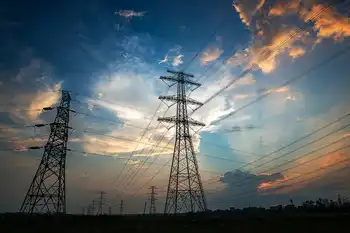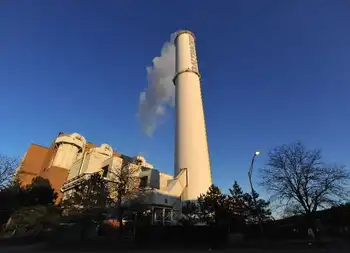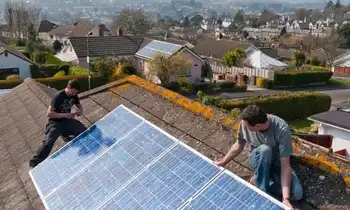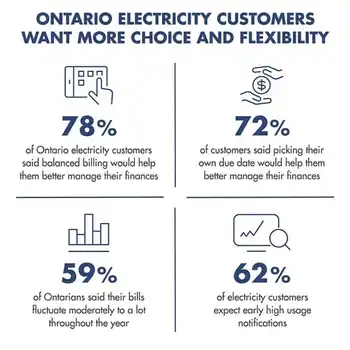A perfect storm coming for the future workforce
WASHINGTON, D.C. - Are there the makings of a "perfect storm" scenario for meeting future workforce needs in the electric power and energy industries? Many people, both casual observers and passionate participants alike, have strongly answered “yes” to this question.
Why?
First, the need for new infrastructure investments in electricity generation, delivery and use technologies will be growing in the years and decades to come. The U.S. Department of EnergyÂ’s Energy Information Administration projects that electricity consumption in the United States will continue to grow through 2030. International growth is expected to be even higher than in the United States. Not only will there be a need for new investments to support the growth, but also to replace and modernize aging assets.
Second, the need for technology innovation is rising, driven by a world beset by new challenges. In the coming decades, the power and energy industries will have to make substantial efforts to support economic progress, particularly in developing nations, while stabilizing carbon dioxide emissions and switching from high-cost, depleting energy resources to more sustainable energy supply systems.
A myriad of technology developments and applications will need to be greatly accelerated, such as renewable and distributed energy resources, clean coal and carbon capture technologies, nuclear energy, advanced energy storage, conversion systems relying on power electronics, “smart” energy delivery and use systems, and energy efficiency to name a few.
Finally, the need for new infrastructure and technology innovations means a steady, if not rising, need for well-trained engineers. This next generation of innovators and technology leaders will be expected to make critical contributions to solving the challenges that we and future generations face. As we begin to address these unprecedented industry challenges, a wave of retirements of experienced power and energy engineers is imminent.
In fact, based on a survey of U.S. electric utilities, the Center for Energy Workforce Development estimated that approximately 46 percent of all engineering jobs in the electric and gas utility industries could become vacant by 2012, due to retirement and other forms of attrition. Recent executive surveys show that workforce issues are among top concerns of energy businesses. A collection of selected documents about power and energy engineering workforce issues is available.
Critical needs have been developing over the past decade or more and continue to advance exponentially in terms of severity due to the aging workforce. To address these concerns, the power and energy engineering industry needs to:
• Replace retiring engineers, so that critical expertise and knowledge transfer is maintained;
• Meet rising infrastructure construction and technology integration needs;
• Modernize the grid as communications, computing and electric energy technologies converge;
• Help stem the tide of electric equipment manufacturing moving overseas;
• Solve arising engineering challenges, such as in the development of advanced power electronics and energy conversion systems, new generation and storage technologies, and the integration of those technologies into the grid.
Last September, the IEEE Power and Energy Society (PES) initiated a free online service called PES Careers to help address emerging engineering workforce challenges for power engineering students and their future employers. The site is being used by a range of businesses — from very small engineering service businesses to electric utilities and large manufacturers. Employers using the site were asked about the future of the industry, and almost half of those that responded said they expected a growing demand for new power engineers over the next 10 years, while almost none expected a declining demand in their future business growth.
More solutions are needed. As industry, government and universities better understand the issues of the aging workforce with the resulting loss of years of experience (and the impact is already beginning to have industry-wide effects), they must become more attentive to solutions and initiatives aimed at addressing this critical situation. Much of what needs to be done will be achieved with strong collaboration among industry, government and academia, especially in preparing the next generation of power and energy engineering professionals.
While in many ways industry faces a crisis situation in workforce issues today, they must set their sights now on preparing for the future. Academia obviously plays a pivotal role in preparing future engineers and in discovering new solutions, so it is obvious that more attention needs to be given to strengthening education and research in university power programs.
Many of the key decision-makers involved in this looming crisis are concerned that there will not be enough students in the pipeline who are excited about and prepared for a post-high school education in power engineering. IEEE PES Power Engineering Education Committee surveys of university power engineering programs show that university education and research infrastructures are being weakened by university decisions to not replace retiring power engineering faculty.
Universities have been putting greater emphasis on hiring faculty in new academic areas, such as biomedical engineering and nanotechnology, where research funding is strong, so there has been a decline in university power engineering programs.
Innovative approaches to educating the next generation of engineers are being tried. Through partnerships among industry, government and universities, new undergraduate and graduate power engineering education programs are being developed and older programs are being renewed and modernized.
At some schools, students and faculty alike are being attracted to the power and energy area, creating a new era for the rebirth of modernized education programs and research tracks in power and energy. The job market for new engineers is extremely healthy and is projected to only improve for new graduates over the next several decades as the aging workforce impacts begin to take hold.
Conversations with power engineering faculty around the United States suggest that there is a strong demand today for students graduating with undergraduate or graduate degrees in power and energy, with many students receiving multiple good offers from which to select. However, more work is needed to boost the number of students entering the power and energy engineering fields, and to sustain power engineering programs across the country for the long term.
Developing modernized education programs and attracting more students to enter the power and energy field is a daunting task. One challenge that demands particular attention is the funding of engineering research programs in the power and energy area. Innovative university research is critical to addressing new engineering challenges, while educating students at the same time.
At research universities, research is central to the education process — education and research are inseparably linked as synergistic university activities. Support for cultivating research activities is increasingly difficult to find. Nonetheless, the role of university research remains vital to moving the industry and academia forward in the power and energy realms.
The need for greatly increased university research is important not only for new and innovative technology advancements, but also for the growth and enhancement of electric power university programs in general. To ensure success with renewed initiatives, we must establish vibrant power engineering programs with growing student interest through sustained research support. Vibrant electric power programs and the ability to continue to attract students are necessary for the continued viability of electric power programs in the United States.
The keys to building, enhancing and sustaining university power engineering programs are (1) establishing avenues and funding for sustained research support, and (2) providing a growing stream of students and faculty needed to meet future workforce needs. Support and funding will be needed from both government and industry sources.
Improving interaction among universities, industry and government is an important step toward obtaining the needed growth of university research. Greater collaboration can yield stimulating ideas for innovative research for faculty and graduate students, as well as for funding and supporting such research. Government participation can provide support for fundamental research that universities are well-equipped to perform.
Industry participation can provide new and sustainable avenues for research funding, and also for innovative education programs that appeal to a new generation of potential students. In cases where collaboration has been successful, the interaction of all levels of industry organization participants, from executives to engineers, has been a key component of obtaining commitment and sustained support.
Addressing intellectual property issues in a collaborative manner is crucial to the success of joint endeavors. Higher levels of successful collaboration can be achieved by carefully selecting research projects that minimize intellectual property issues given the needs of faculty and graduate students to publish research results.
To enhance interactions, we must first create opportunities for university power engineering faculty to engage proactively with regional industry partners to develop relationships and understanding. We need to facilitate such partnerships across the country by increasing awareness that university research is an essential element of a well-rounded, high-quality education system. Many of the ideas expressed above resulted from discussions at the National Science FoundationÂ’s (NSF) Workshop on the Future Power Engineering Workforce in November 2007. The Workshop was co-sponsored by the IEEE Power Engineering Society (PES), the North American Electric Reliability Corporation, and the Power Systems Engineering Research Center.
Approximately 75 industry, government and university representatives came together to discuss how to prepare universities for the forthcoming significant increase in demand for new power and energy engineers. An executive summit, comprised of key leaders in industry, government and academia, was also part of the workshop. In the discussions, workshop and summit, participants identified key issues and possible actions for meeting the future demand for new power and energy engineers.
Attendees at the workshop and executive summit concluded that a coordinated effort by industry, government and universities is needed now to prepare for the coming exodus of retiring engineers. Without such an effort, there will be a lag in replacing the lost expertise needed to maintain economic, reliable and environmentally acceptable electric service, while innovatively solving the significant technical challenges facing all industries. The workshop recommendations call for:
1. Creating a single, collaborative voice on solutions to engineering workforce challenges;
2. Strengthening the case for extraordinary efforts to build, enhance, and sustain university power engineering programs;
3. Envisioning the future challenges in electric energy supply and demand, and developing an image that will increase interest in power and energy engineering careers;
4. Stimulating interest in power and energy engineering careers and preparing students for a post-high school engineering education in power and energy engineering;
5. Making the higher education experience relevant, stimulating, and effective in creating high quality and professional power and energy engineers;
6. Encouraging and supporting increased university research to find innovative solutions and enhance student education.
The workshop and executive summit demonstrated that there are collective concerns across industry, government and universities about power engineering workforce issues.
The time the attendees spent together was sufficient to generate wide-ranging discussion about how to address the issues, but not long enough to reach a consensus on what comprehensive approach should be pursued.
To make progress toward finding and implementing solutions to the concerns that came out of the workshop and executive summit, the IEEE PES, under the leadership of President Wanda Reder, has initiated the Power and Energy Engineering Workforce Collaborative.
PES will seek partners from industry, government and universities to work on this initiative. Existing efforts and organizations will be used to the maximum extent possible; however, it is possible that new institutions or organizations will be needed to sustain the initiative. Industries beyond electric power may also be involved.
One of the first steps will be to form an executive council of key decision-makers from industry, government and universities to plan a comprehensive approach that will be widely supported and initiate actions that are necessary, timely and supportable with available resources. The executive council will provide a single, cohesive voice on solutions to the power and energy engineering workforce challenges.
Working groups in outreach and image, education and research will be created to inform the executive councilÂ’s decision-making. Working groups will scope tasks, identify where further action is needed, do what they can themselves, plan needed changes, and negotiate with others to implement actions.
Organizational partners will be sought to help make this initiative successful in the long-term. Despite the immediacy of the problem, the PES initiative will not be just a short-term effort; long-term needs for educating well-trained, high quality engineers, and for conducting research for the innovations that solve regional and global challenges will persist for years to come. The effort is seeking transformation in the relationships among industry, government and universities to achieve a sustainable education and research system in power and energy engineering.
Although the PES initiative has just begun, Reder is optimistic that the actions proposed will address workforce and education challenges in the power and energy engineering industry. “By working together,” said Reder, “we can be more effective than working separately.”
Related News

Quebec authorizes nearly 1,000 megawatts of electricity for 11 industrial projects
MONTREAL - The Quebec government has unveiled the list of 11 companies whose projects were given the go-ahead for large-scale power connections of 5 megawatts or more, for a total of 956 MW.
Five of the selected projects relate to the battery sector, and two to the bioenergy sector.
TES Canada's plan to build a green hydrogen production plant in Shawinigan, announced on Friday, is on the list.
Hydro-Québec will also supply 5 MW or more to the future Northvolt plant at its facilities in Saint-Basile-le-Grand and McMasterville.
Other industrial projects selected are those of Air Liquide Canada, Ford-Ecopro CAM Canada S.E.C, Nouveau monde…




